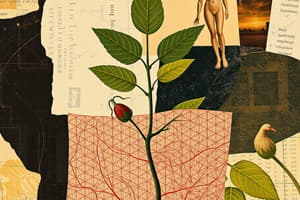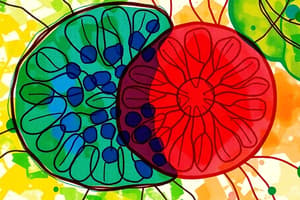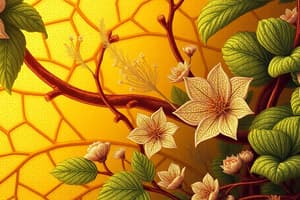Podcast
Questions and Answers
What role do guard cells play in plant physiology?
What role do guard cells play in plant physiology?
- They store nutrients needed for photosynthesis.
- They synthesize chlorophyll in plant cells.
- They regulate the opening and closing of stomata. (correct)
- They transport glucose throughout the plant.
Which of the following are considered reactants in the process of photosynthesis?
Which of the following are considered reactants in the process of photosynthesis?
- Water and carbon dioxide (correct)
- Water and light
- Carbon dioxide and glucose
- Oxygen and glucose
What is a primary advantage of seed-producing plants over non-seed producing plants?
What is a primary advantage of seed-producing plants over non-seed producing plants?
- Their seeds have a hard coat that protects the embryo. (correct)
- They can perform photosynthesis more efficiently.
- They require less water for survival.
- They can reproduce without fertilization.
What is the main product of cellular respiration?
What is the main product of cellular respiration?
Which type of respiration occurs in muscle cells when oxygen is not available?
Which type of respiration occurs in muscle cells when oxygen is not available?
Flashcards are hidden until you start studying
Study Notes
Plant Structure and Function
- Ground Tissue is important for photosynthesis and food storage and provides structure.
- Dermal Tissues prevent water loss, which is essential for photosynthesis.
- Xylem transports water from the roots to the rest of the plant, including the leaves, supplying the water needed for photosynthesis.
- Phloem transports glucose (sugar), which is produced during photosynthesis, to different parts of the plant for growth and energy.
- Stomata facilitate gas exchange, allowing carbon dioxide to enter and oxygen to be released. They close when plants lose too much water, which happens faster in plants with more leaves due to the presence of more stomata.
- Guard Cells control the opening and closing of stomata by regulating the intake and release of gases.
- Meristematic Tissue contains stem cells, allowing the plant to grow by constantly producing new cells for various organs.
- Photosynthetic Organisms like zooxanthellae are essential for producing glucose and oxygen, which are crucial for many ecosystems.
- Ovules develop into seeds, providing protection for the developing embryo. This adaptation offers an advantage to seed-producing plants over non-seed producing plants.
- Ovary develops into the fruit, which helps to attract animals to disperse seeds.
Photosynthesis
- Reactants of photosynthesis are carbon dioxide and water.
- Light energy is required to drive the process of photosynthesis.
- Products of photosynthesis are glucose (sugar) and oxygen.
- Increasing the amount of light increases the rate of photosynthesis because light is the energy source for the process.
Cellular Respiration
- ATP is the primary energy currency of cells and is produced through cellular respiration.
- Aerobic respiration requires oxygen for the process.
- Anaerobic respiration (fermentation) does not require oxygen. It is used by muscle cells when oxygen is scarce, converting pyruvate to lactic acid.
Studying That Suits You
Use AI to generate personalized quizzes and flashcards to suit your learning preferences.




